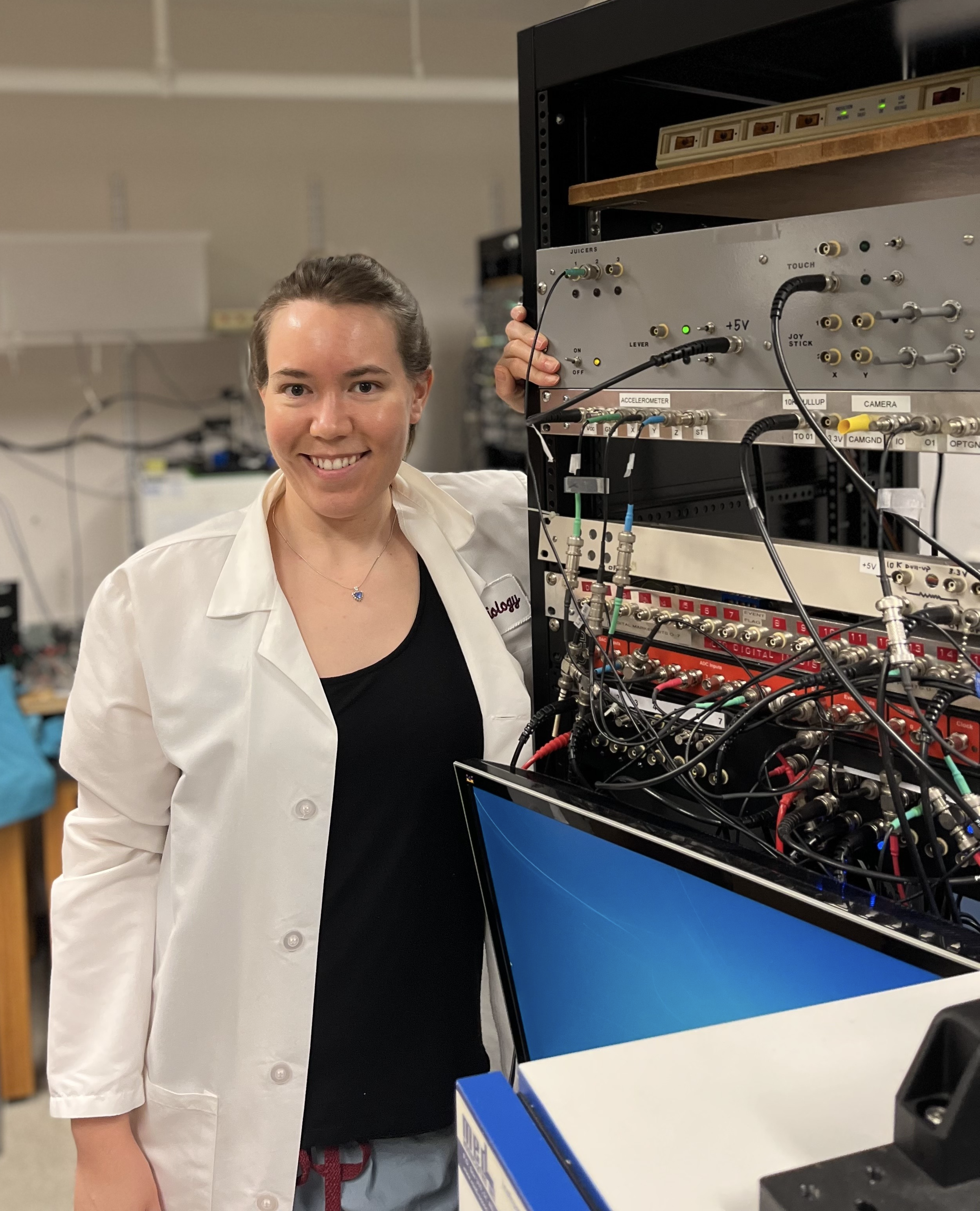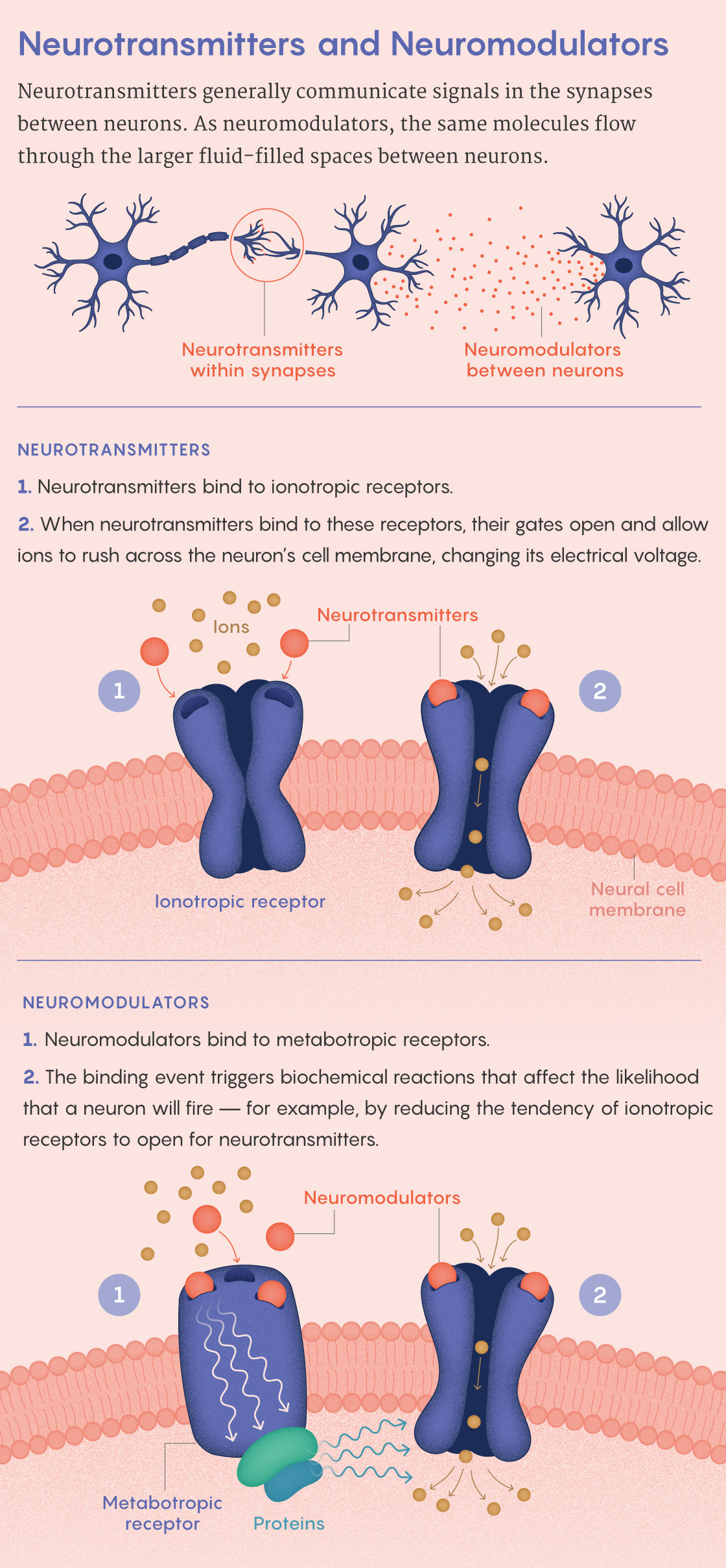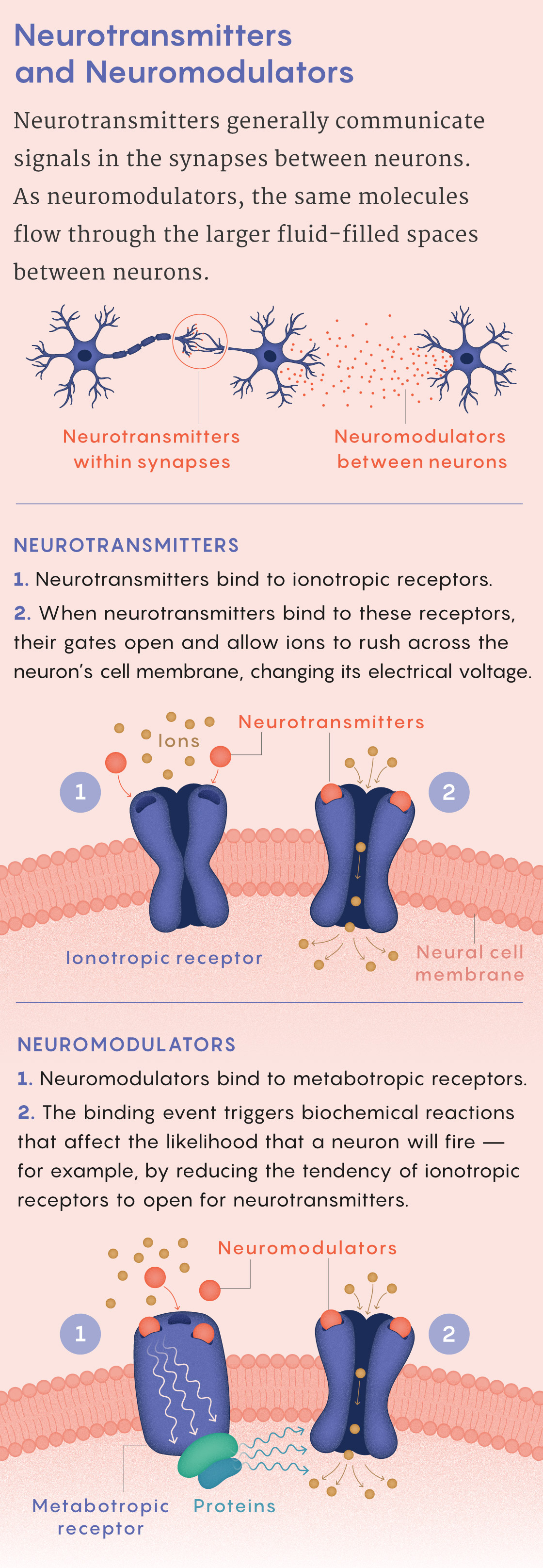Brain Chemical Helps Signal to Neurons When to Start a Movement
Introduction
Every time you reach for your coffee mug, a neuroscientific mystery takes shape. Moments before you voluntarily extend your arm, thousands of neurons in the motor regions of your brain erupt in a pattern of electrical activity that travels to the spinal cord and then to the muscles that power the reach. But just prior to this massively synchronized activity, the motor regions in your brain are relatively quiet. For self-driven movements like reaching for your coffee, the “go” signal that tells the neurons precisely when to act — instead of the moment just before or after — has yet to be found.
In a recent paper in eLife, a group of neuroscientists led by John Assad at Harvard Medical School finally reveals a key piece of the signal. It comes in the form of the brain chemical known as dopamine, whose slow ramping up in a region lodged deep below the cortex closely predicted the moment that mice would begin a movement — seconds into the future.
Dopamine is commonly known as one of the brain’s neurotransmitters, the fast-acting chemical messengers that are shuttled between neurons. But in the new work, dopamine is acting as a neuromodulator. It’s a term for chemical messengers that slightly alter neurons to cause longer-lasting effects, including making a neuron more or less likely to electrically communicate with other neurons. This neuromodulatory tuning mechanism is perfect for helping to coordinate the activity of large populations of neurons, as dopamine is likely doing to help the motor system decide precisely when to make a movement.
The new paper is one of the latest results to expand our knowledge of the crucial and varied roles that neuromodulators play in the brain. With recent advances in technology, neuroscientists can now view neuromodulators at work in networks that traverse the entire brain. The new findings are overturning some long-held views about these modulators adrift in the brain, and they’re revealing exactly how these molecules allow the brain to flexibly change its internal state amid ever-changing environments.
Modulating Movement
To identify what contributes to the sudden decision of when to move, Assad and his colleagues trained mice to recognize that a licking movement would bring them a juice reward — but only if they timed the lick to occur between 3.3 and 7 seconds after a cue from a paired tone and flash of light. The mice therefore had a flexible window of time in which they could decide to move at any instant. The timing of their movement consequently varied widely across trials.
But whenever the movement occurred, the researchers found that it followed almost immediately after the rising level of dopamine in the fluid-filled space around neurons seemed to reach a certain threshold. When dopamine rose very quickly, the movement happened early in the response period; when dopamine rose slowly, the movement happened later.

Work in the laboratory of John Assad, a neuroscientist at Harvard Medical School, has revealed that the neuromodulator dopamine plays a critical role in determining the timing of some voluntarily initiated motions.
Photo courtesy of Anna Olivella and the Harvard Brain Science Initiative
The moment-to-moment influence of dopamine “blew me away,” said Assad. “I still find that surprising.”
But the movement didn’t happen every time the dopamine level passed the critical threshold — an inconsistency that jibes with what might be expected of a neuromodulator, noted Allison Hamilos, an M.D.-Ph.D. student at Harvard and the first author on the paper. Neuromodulatory chemicals effect changes that make it more or less likely for neurons to fire, but it’s not a one-to-one correspondence every time. Dopamine was a major component of the signal that told the mice exactly when to move in this case, but other neuromodulators and neural activity that play a role in the “go” signal for movement still need further investigation.
Mark Howe, a neuroscientist at Boston University, hailed the paper as “an important contribution” and said, “The idea that there’s a slowly varying change in the dopamine signal that’s influencing when to move is novel. … I wouldn’t have expected that.”
Previous work from Howe and others over the past decade demonstrated that dopamine levels rise rapidly tens or hundreds of milliseconds before an action occurs. So neuroscientists knew that dopamine was involved in signaling whether or not a movement should be initiated. The new paper shows that dopamine levels are also slowly evolving over many seconds to directly influence the decision about not just whether to move but exactly when to do it. It could help explain why patients with Parkinson’s disease — a movement disorder in which dopamine levels are reduced — have trouble initiating movements with proper timing: Their slowly evolving dopamine levels may rarely reach the critical threshold.

Allison Hamilos of Harvard Medical School, the first author on the new research paper, found that the initiation of a trained movement appeared to happen quickly after dopamine levels passed a certain threshold.
Eden Sayed
The role of dopamine as a neuromodulator of movement is a relatively new discovery. Neuroscientists have long studied the role that dopamine plays in signaling to the brain that a reward might be imminent. Indeed, Assad’s team thinks it’s possible that the slowly evolving ramps of dopamine they saw could be the same ramping signals that the brain uses to determine whether a reward is coming soon. The brain may have evolved to effectively harness the reward signal to decide exactly when to move as well, the scientists suggest.
As for why a neuromodulator like dopamine would be involved in deciding when to move, it’s possible that slowly varying neuromodulatory signals could allow the brain to adapt to its environment. Such flexibility wouldn’t be afforded by a signal that always led to movement at the exact same time. “The animal is always uncertain, to some extent, about what the true state of the world is,” said Hamilos. “You don’t want to do things the same way every single time — that could be potentially disadvantageous.”
Slowly Shaping Behavior
Although some of the functions of neuromodulators have been known for many decades, neuroscientists are still early in the quest to learn how much they can do and how they do it. There’s widespread agreement that all neurotransmitters, like dopamine, can act as neuromodulators under certain conditions. Which role a molecule is playing in given circumstances tends to be defined by its function and activity. In general, neurotransmitters are released from one neuron into the synaptic space that connects it to another neuron; within milliseconds, they cause the gates of ionotropic receptor proteins to open and allow ions and other charged molecules to flood into a neuron, changing its internal voltage. Once the voltage passes a threshold value, the neuron fires an electrical signal to other neurons.
In contrast, neuromodulators are often released en masse at sites all over the cortex to seep through brain fluid and reach many more neurons. Binding to metabotropic receptors, they act over seconds and minutes to make it more or less likely that the neuron will fire an electrical signal. Neuromodulators can also alter the strength of connections between neurons, turn up the “volume” of certain neurons compared to others, and even affect which genes get turned on or off. These changes happen to individual neurons, but when a whole network is blanketed with neuromodulator molecules landing on the receptors of thousands or millions of neurons, the molecules can influence every neural function, from sleep-wake cycles to attention and learning.


Kristina Armitage and Samuel Velasco/Quanta Magazine
By washing through the brain, neuromodulators “allow you to govern the excitability of a large region of the brain more or less in the same way or at the same time,” said Eve Marder, a neuroscientist at Brandeis University widely recognized for her pioneering studies on neuromodulators in the late 1980s. “You’re basically creating either a local brain wash or more extended brain wash that is changing the state of a lot of networks simultaneously.”
The powerful effects of neuromodulators mean that abnormal levels of these chemicals can lead to numerous human diseases and mood disorders. But within their optimal levels, neuromodulators are like secret puppeteers holding the strings of the brain, endlessly shaping circuits and shifting activity patterns into whatever may be most adaptive for the organism, moment by moment.
“The neuromodulatory system [is] the most brilliant hack you can imagine,” said Mac Shine, a neurobiologist at the University of Sydney. “Because what you’re doing is you’re sending a very, very diffuse signal … but the effects are precise.”
Shifting Brain States
In the past few years, a burst of technological advances has paved the way for neuroscientists to go beyond studies of neuromodulators in small circuits to studies looking across the whole brain in real time. They have been made possible by a new generation of sensors that modify the metabotropic neuronal receptors — making them light up when a specific neuromodulator lands on them.

The researcher Yulong Li of Peking University in Beijing has developed a number of sensors that are advancing studies of neuromodulators and their effects.
Tianjun Zhao
The lab of Yulong Li at Peking University in Beijing has developed many of these sensors, beginning with the first sensor for the neuromodulator acetylcholine in 2018. The team’s work lies in “harnessing nature’s design” and taking advantage of the fact that these receptors have already evolved to expertly detect these molecules, said Li.
Jessica Cardin, a neuroscientist at Yale University, calls the recent studies using these sensors “the tip of the iceberg, where there’s going to be this enormous wave of people using all of those tools.”
In a paper posted in 2020 on the preprint server bioarxiv.org, Cardin and her colleagues became the first to use Li’s sensor to measure acetylcholine across the entire cortex in mice. As a neuromodulator, acetylcholine regulates attention and shifts brain states related to arousal. It was widely believed that acetylcholine always increased alertness by making neurons more independent of the activity in their circuits. Cardin’s team found that this holds true in small circuits with only hundreds to thousands of neurons. But in networks with billions of neurons the opposite occurs: Higher levels of acetylcholine lead to more synchronization of activity patterns. Yet the amount of synchronization also depends on the region of the brain and the arousal level, painting the picture that acetylcholine does not have uniform effects everywhere.
Another study published in Current Biology last November similarly upended long-held notions about the neuromodulator norepinephrine. Norepinephrine is part of a monitoring system that alerts us to sudden dangerous situations. But since the 1970s, it’s been thought that norepinephrine is not involved in this system during certain stages of sleep. In the new study, Anita Lüthi at the University of Lausanne in Switzerland and her colleagues used Li’s new norepinephrine sensor and other techniques to show for the first time that norepinephrine doesn’t shut down during all stages of sleep, and indeed plays a role in rousing the animal if need be.
“We were extremely surprised,” said Lüthi. “[Our result] brings sleep into a different realm of states. It’s not just shutting down what happens in wakefulness.”
Modulating the Neuromodulators
Though the new studies by the labs of Assad, Cardin and Lüthi studied only one neuromodulator at a time, the scientists emphasized that neuromodulators always work in tandem. Many labs are now aiming to study multiple neuromodulators simultaneously for a more complete picture of their influence on the brain.
Researchers are also looking at evidence that that some neuromodulators modulate one another. For example, endocannabinoids, the neuromodulators that bind to the same receptors as the active component in marijuana, seem to help keep the amount of neuromodulators released by individual neurons within an optimal range.
That’s why endocannabinoids are “crucial to our survival,” said Joseph Cheer, a neuroscientist at the University of Maryland School of Medicine who has been studying their impact on dopamine for nearly 20 years. “We have these little molecules that are fine-tuning most synapses in our brain.”
To Marder, studying neuromodulators in isolation is “akin to looking under the lightbulb for your keys just because that’s where there’s light,” she said. “Nothing about modulation is ever linear or simple.”





